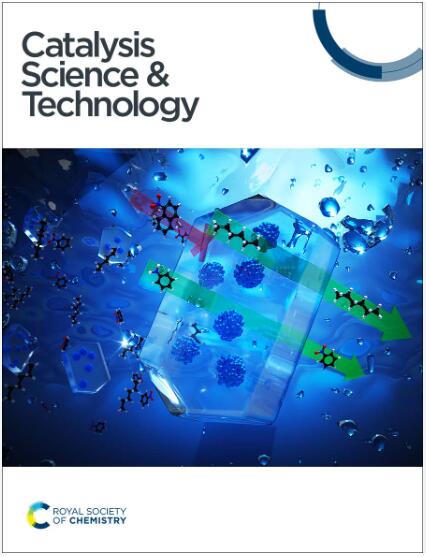Tailored support reduction of Cu/SrTiO3 catalysts for enhanced methanol production†
IF 4.4
3区 化学
Q2 CHEMISTRY, PHYSICAL
引用次数: 0
Abstract
Copper supported on strontium titanate is explored as a catalyst in the hydrogenation of carbon dioxide to methanol. We used combined H2-TPR, O2-TPO, XPS, and STEM-EDX to identify the support defects, tailored by the activation procedure. Strontium titanate forms oxygen vacancies under high-temperature reductive treatments. The extent of its reduction is a function of the copper content and of the pressure; the highest extent is achieved at 2 wt% copper and 20 bar hydrogen. The catalytic data agree with a direct relationship between the methanol selectivity and the concentration of the oxygen vacancies, with the best results being: 90% (10% towards carbon monoxide) and an associated methanol space time yield of 0.49 gMeOH gcat−1 h−1. The selectivity is higher than that achieved on a typical copper catalyst on zinc oxide alumina, while keeping the competitive productivity value, despite having thirty times lower copper content. Post-reaction characterisation suggests that these sites are stable under reaction conditions. We propose a dual-site surface mechanism based on oxygen vacancies formed at the copper–support interface and via long-distance hydrogen spillover.
量身定制的Cu/SrTiO3催化剂的支持还原,以提高甲醇产量†
研究了钛酸锶负载铜在二氧化碳加氢制甲醇中的催化作用。我们结合使用H2-TPR、O2-TPO、XPS和STEM-EDX来识别支撑缺陷,并根据激活过程进行调整。钛酸锶在高温还原处理下形成氧空位。其还原程度是铜含量和压力的函数;最大程度是在2 wt%的铜和20 bar的氢。甲醇选择性与氧空位浓度之间存在直接关系,最佳结果为:90%(对一氧化碳为10%),甲醇时空产率为0.49 gMeOH gcat−1 h−1。选择性高于氧化锌氧化铝上的典型铜催化剂,同时保持具有竞争力的生产率值,尽管铜含量降低了30倍。反应后的表征表明这些位点在反应条件下是稳定的。我们提出了一种基于在铜-载体界面上形成氧空位并通过远距离氢溢出的双点表面机制。
本文章由计算机程序翻译,如有差异,请以英文原文为准。
求助全文
约1分钟内获得全文
求助全文
来源期刊

Catalysis Science & Technology
CHEMISTRY, PHYSICAL-
CiteScore
8.70
自引率
6.00%
发文量
587
审稿时长
1.5 months
期刊介绍:
A multidisciplinary journal focusing on cutting edge research across all fundamental science and technological aspects of catalysis.
Editor-in-chief: Bert Weckhuysen
Impact factor: 5.0
Time to first decision (peer reviewed only): 31 days
 求助内容:
求助内容: 应助结果提醒方式:
应助结果提醒方式:


